Title search results
Showing 1488361 - 1488380 of 1502779 items
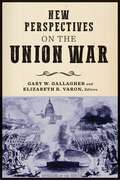
New Perspectives on the Union War (The North's Civil War)
By Gary W. Gallagher and Elizabeth R. Varon. 2019
Edited by Gary Gallagher and Elizabeth Varon, two of the most prominent nineteenth-century American historians in the nation, New Perspectives…
on the Union War provides a more nuanced understanding of what “Union” meant in the Civil War North by exploring how various groups of northerners conceived of the term. The essays in this volume demonstrate that while there was a broad consensus that the war was fought, or should be fought, for the cause of Union, there was bitter disagreement over how to define that cause—debate not only between political camps but also within them. The chapters touch on economics, politics, culture, military affairs, ethnicity, and questions relating to just war.Contributors: Michael T. Caires, Frank Cirillo, D.H. Dilbeck, Jack Furniss, Jesse George-Nichol, William B. Kurtz, Peter C. Luebke, and Tamika Nunley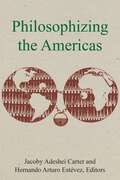
Philosophizing the Americas
By Jacoby Adeshei Carter and Hernando A. Estévez. 2024
Philosophizing the Americas establishes the field of inter-American philosophy. Bringing together contributors who work in Africana Philosophy, Afro-Caribbean philosophy, Latin…
American philosophy, Afro-Latin philosophy, decolonial theory, and African American philosophy, the volume examines the full range of traditions that have, separately and in conversation with each other, worked through how philosophy in both establishes itself in the Americas and engages with the world from which it emerges.The book traces a range of questions, from the history of philosophy in the Americas to philosophical questions of race, feminism, racial eliminativism, creolization, epistemology, coloniality, aesthetics, and literature. The essays place an impressive range of philosophical traditions and figures into dialogue with one another: some familiar, such as José Martí, Sylvia Wynter, Martin R. Delany, José Vasconcelos, Alain Locke, as well as such less familiar thinkers as Arturo Alfonso Schomburg, Hilda Hilst, and George Lamming. In each chapter, the contributors find fascinating and productive matrices of tension or convergence in works throughout the Americas. The result is an original and important contribution to knowledge that introduces readers from various disciplines to unfamiliar yet compelling ideas and considers familiar texts from novel and prescient perspectives. Philosophizing the Americas stands alone as a representation of current scholarly debates in the field of inter-American philosophy.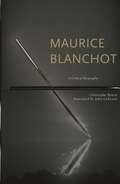
Maurice Blanchot: A Critical Biography
By Christophe Bident. 2019
Maurice Blanchot (1907–2003) was one of the most important writers of the twentieth century. His novels, shorter narratives, literary criticism,…
and fragmentary texts exercised enormous influence over several generations of writers, artists, and philosophers. In works such as Thomas the Obscure, The Instant of my Death, The Writing of the Disaster, The Unavowable Community, Blanchot produced some of the most incisive statements of what it meant to experience the traumas and turmoils of the twentieth century.As a journalist and political activist, Blanchot had a public side that coexisted uneasily with an inclination to secrecy, a refusal of interviews and photographs, and a reputation for mysteriousness and seclusion. These public and private Blanchots came together in complicated ways at some of the twentieth century's most momentous occasions. He was among the public intellectuals participating in the May ’68 revolution in Paris and helped organize opposition to the Algerian war. During World War II, he found himself moments away from being executed by the Nazis. More controversially, he had been active in far-right circles in the ’30s.Now translated into English, Christophe Bident’s magisterial, scrupulous, much-praised critical biography provides the first full-length account of Blanchot’s itinerary, drawing on unpublished letters and on interviews with the writer’s close friends. But the book is both a biography and far more. Beyond filling out a life famous for its obscurity, Bident’s book will transform the way readers of Blanchot respond to this major intellectual figure by offering a genealogy of his thought, a distinctive trajectory that is at once imaginative and speculative, at once aligned with literary modernity and a close companion and friend to philosophy.The book is also a historical work, unpacking the ‘transformation of convictions’ of an author who moved from the far-right in the 1930s to the far-left in the 1950s and after. Bident’s extensive archival research explores the complex ways that Blanchot’s work enters into engagement with his contemporaries, making the book also a portrait of the circles in which he moved, which included friends such as Georges Bataille, Marguerite Duras, Emmanuel Levinas, Michel Foucault, and Jacques Derrida.Finally, the book traces the strong links between Blanchot’s life and an oeuvre that nonetheless aspires to anonymity. Ultimately, Bident shows how Blanchot’s life itself becomes an oeuvre—becomes a literature that bears the traces of that life secretly. In its even-handed appraisal, Bident’s sophisticated reading of Blanchot’s life together with his work offers a much-needed corrective to the range of cruder accounts, whether from Blanchot’s detractors or from his champions, of a life too easily sensationalized.This definitive biography of a seminal figure of our time will be essential reading for anyone concerned with twentieth-century literature, thought, culture, and politics.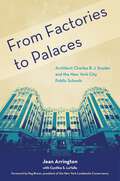
From Factories to Palaces: Architect Charles B. J. Snyder and the New York City Public Schools
By Jean Arrington. 2022
WINNER, THE VICTORIAN SOCIETY NEW YORK, 2022 BOOK AWARDHow a prolific yet little-known architect changed the face of education in…
New York CityAs Superintendent of School Buildings from 1891 to 1922, architect Charles B. J. Snyder elevated the standards of school architecture. Unprecedented immigration and Progressive Era changes in educational philosophy led to his fresh approach to design and architecture, which forever altered the look and feel of twentieth-century classrooms and school buildings. Students rich or poor, immigrant or native New Yorker, went from learning in factory-like schools to attending classes in schools with architectural designs and enhancements that to many made them seem like palaces. Spanning three decades, From Factories to Palaces provides a thought-provoking narrative of Charles Snyder and shows how he integrated his personal experiences and innovative design skills with Progressive Era school reform to improve students’ educational experience in New York City and, by extension, across the nation.During his thirty-one years of service, Snyder oversaw the construction of more than 400 New York City public schools and additions, of which more than half remain in use today. Instead of blending in with the surrounding buildings as earlier schools had, Snyder’s were grand and imposing. “He does that which no other architect before his time ever did or tried: He builds them beautiful,” wrote Jacob Riis. Working with the Building Bureau, Snyder addressed the school situation on three fronts: appearance, construction, and function. He re-designed schools for greater light and air, improved their sanitary facilities, and incorporated quality-of-life features such as heated cloakrooms and water fountains.Author and educator Dr. Jean Arrington chronicles how Snyder worked alongside a group of like-minded, hardworking individuals—Building Bureau draftsmen, builders, engineers, school administrators, teachers, and custodians—to accomplish this feat.This revelatory book offers fascinating glimpses into the nascent world of modern education, from the development of specialty areas, such as the school gymnasium, auditorium, and lunchroom, to the emergence of school desks with backs as opposed to uncomfortable benches, all housed in some of the first fireproofed schools in the nation. Thanks to Snyder, development was always done with the students’ safety, well-being, and learning in mind. Lively historical drawings, architectural layouts, and photographs of school building exteriors and interiors enhance the engaging story.Funding for this book was provided by: Furthermore: a program of the J. M. Kaplan Fund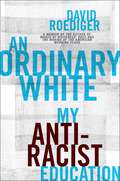
An Ordinary White: My Antiracist Education
By David Roediger. 2025
A prize-winning historian details his intellectual and political evolution Written by the author of the landmark book The Wages of…
Whiteness and one of the key figures in the critical study of race and racism in America, An Ordinary White is the life story of the historian and radical American writer, David Roediger.With wry wit and keen observation, Roediger chronicles his intellectual and political evolution from growing up in his southern Midwest sundown town to becoming a leading figure in working-class history and Whiteness studies. A latecomer to the New Left, a longtime figure in the Chicago Surrealist Group, and part of the collective reviving of the Charles Kerr Company—the world’s oldest socialist publisher—Roediger captures events and characters absent from standard histories of the left as well as such icons of resistance as Studs Terkel, Noel Ignatiev, Angela Davis, Toni Morrison, and C. L. R. James.A direct response to the venom, effectiveness, and durability of white nationalist attacks on Critical Race Theory, this memoir describes Roediger’s youth as “ordinary,” both in its unfolding in a lower-middle-class family of southern Illinois workers and in the depth of white racism he was taught. He considers himself “saved” by social movements of his time, including those of labor, against empire, and, above all, the Black Freedom struggle. Public education, dissenting currents in Catholicism, knowledge of the importance of good union jobs, and generative impulses in sports and music helped make his salvation stick.Roediger’s knowledge of white advantage came from his personal everyday experiences, but among people ordinary enough to guard against the mistaken notion that poor and working-class whites are uniquely the culprits of white nationalism. Importantly he argues against the characterization of them as intractably racist or incapable of understanding the advantages of whiteness. A teacher in state universities for forty years, Roediger has tirelessly fought against their being hollowed out by corporate values and austerity. In An Ordinary White, he writes movingly of these experiences and what we have lost in our institutions whose soaring rhetoric outstrips any ability to defend education or racial justice.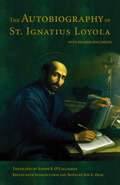
The Autobiography of St. Ignatius Loyola
By John C. Olin. 1992
Available in a new digital edition with reflowable text suitable for e-readersFrom the Introduction: “The autobiography...does not cover the complete…
life of Ignatius. It begins abruptly in 1521 at the great turning point in the saint’s life – his injury in the battle of Pamplona when the French occupied that town and attacked its citadel. It then spans the next seventeen years up to the arrival of Ignatius and his early companions in Rome…These years are the central years of Ignatius’s life. They are the years…that open with his religious conversion and that witness his spiritual growth. They are the years of pilgrimage, to use his own designation, of active travel and searching, and of interior progress in the Christian life. They are the years of preparation for the establishment of the great religious order he will found and for its dynamic thrust in the turbulent Europe and the expanding world of his day.”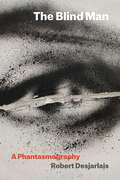
The Blind Man: A Phantasmography (Thinking from Elsewhere)
By Robert Desjarlais. 2019
The Blind Man: A Phantasmography examines the complicated forces of perception, imagination, and phantasms of encounter in the contemporary world.…
In considering photographs he took while he was traveling in France, anthropologist and writer Robert Desjarlais reflects on a few pictures that show the features of a man, apparently blind, who begs for money at a religious site in Paris, frequented by tourists. In perceiving this stranger and the images his appearance projects, he begins to imagine what this man’s life is like and how he perceives the world around him.Written in journal form, the book narrates Desjarlais’s pursuit of the man portrayed in the photographs. He travels to Paris and tries to meet with him. Eventually, Desjarlais becomes unsure as to what he sees, hears, or remembers. Through these interpretive dilemmas he senses the complexities of perception, where all is multiple, shifting, spectral, a surge of phantasms in which the actual and the imagined are endlessly blurred and intertwined. His mind shifts from thinking about photographs and images to being fixed on the visceral force of apparitions. His own vision is affected in a troubling way.Composed of an intricate weave of text and image, The Blind Man attends to pressing issues in contemporary life: the fraught dimensions of photographic capture; encounters with others and alterity; the politics of looking; media images of violence and abjection; and the nature of fantasy and imaginative construal. Through a wide-ranging inquiry into histories of imagination, Desjarlais inscribes the need for a “phantasmography”—a writing of phantasms, a graphic inscription of the flows and currents of fantasy and fabulation.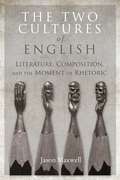
The Two Cultures of English: Literature, Composition, and the Moment of Rhetoric
By Jason Maxwell. 2018
The Two Cultures of English examines the academic discipline of English in the final decades of the twentieth century and…
the first years of the new millennium. During this period, longstanding organizational patterns within the discipline were disrupted. With the introduction of French theory into the American academy in the 1960s and 1970s, both literary studies and composition studies experienced a significant reorientation.The introduction of theory into English studies not only intensified existing tensions between those in literature and those in composition but also produced commonalities among colleagues that had not previously existed. As a result, the various fields within English began to share an increasing number of investments at the same time that institutional conflicts between them became more intense than ever before.Through careful reconsiderations of some of the key figures who shaped and were shaped by this new landscape—including Michel Foucault, Kenneth Burke, Paul de Man, Fredric Jameson, James Berlin, Susan Miller, John Guillory, and Bruno Latour—the book offers a more comprehensive map of the discipline than is usually understood from the perspective of either literature or composition alone.Possessing a clear view of the entire discipline is essential today as the contemporary corporate university pushes English studies to abandon its liberal arts tradition and embrace a more vocational curriculum. This book provides important conceptual tools for responding to and resisting in this environment.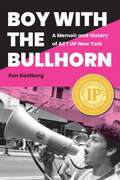
Boy with the Bullhorn: A Memoir and History of ACT UP New York
By Ron Goldberg. 2022
Winner, "Gold" Independent Publishing Award (IPPY) for LGBTQ+ NonfictionWinner, The Randy Shilts Award for Gay Nonfiction, 34th Annual Triangle Awards2023…
Lammy Finalist, Gay Memoir/BiographyA coming-of-age memoir of life on the front lines of the AIDS crisis with ACT UP New York.From the moment Ron Goldberg stumbled into his first ACT UP meeting in June 1987, the AIDS activist organization became his life. For the next eight years, he chaired committees, planned protests, led teach-ins, and facilitated their Monday night meetings. He cruised and celebrated at ACT UP parties, attended far too many AIDS memorials, and participated in more than a hundred zaps and demonstrations, becoming the group’s unofficial “Chant Queen,” writing and leading chants for many of their major actions. Boy with the Bullhorn is both a memoir and an immersive history of the original New York chapter of ACT UP, the AIDS Coalition to Unleash Power, from 1987 to 1995, told with great humor, heart, and insight.Using the author’s own story, “the activist education of a well-intentioned, if somewhat naïve nice gay Jewish theater queen,” Boy with the Bullhorn intertwines Goldberg’s experiences with the larger chronological history of ACT UP, the grassroots AIDS activist organization that confronted politicians, scientists, drug companies, religious leaders, the media, and an often uncaring public to successfully change the course of the AIDS epidemic.Diligently sourced and researched, Boy with the Bullhorn provides both an intimate look into how activist strategies are developed and deployed and a snapshot of life in New York City during the darkest days of the AIDS epidemic. On the occasions where Goldberg writes outside his personal experience, he relies on his extensive archive of original ACT UP documents, news articles, and other published material, as well as activist videos and oral histories, to help flesh out actions, events, and the background stories of key activists. Writing with great candor, Goldberg examines the group’s triumphs and failures, as well as the pressures and bad behaviors that eventually tore ACT UP apart.A story of ordinary people doing extraordinary things, from engaging in outrageous, media-savvy demonstrations, to navigating the intricacies of drug research and the byzantine bureaucracies of the FDA, NIH, and CDC, Boy with the Bullhorn captures the passion, smarts, and evanescent spirit of ACT UP—the anger, grief, and desperation, but also the joy, camaraderie, and sexy, campy playfulness—and the exhilarating adrenaline rush of activism.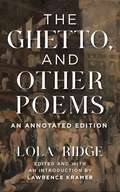
The Ghetto, and Other Poems: An Annotated Edition
By Lola Ridge. 2023
At last recovered in this enriching annotated edition, this important but neglected work of American modernism offers a unique poetic…
encounter with the Jewish communities in New York’s Lower East Side.Long forgotten on account of her gender and left-wing politics, Lola Ridge is finally being rediscovered and read alongside such celebrated contemporaries as Hart Crane, William Carlos Williams, and Marianne Moore—all of whom knew her and admired her work. In her time Ridge was considered one of America’s leading poets, but after her death in 1941 she and her work effectively disappeared for the next seventy-five years. Her book The Ghetto and Other Poems, is a key work of American modernism, yet it has long, and unjustly, been neglected. When it was first published in 1918—in an abbreviated version in The New Republic, then in full by B. W. Huebsch five months later—The Ghetto and Other Poems was a literary sensation. The poet Alfred Kreymbourg, in a Poetry Magazine review, praised “The Ghetto” for its “sheer passion, deadly accuracy of versatile images, beauty, richness, and incisiveness of epithet, unfolding of adventures, portraiture of emotion and thought, pageantry of pushcarts—the whole lifting, falling, stumbling, mounting to a broad, symphonic rhythm.” Louis Untermeyer, writing in The New York Evening Post, found “The Ghetto” “at once personal in its piercing sympathy and epical in its sweep. It is studded with images that are surprising and yet never strained or irrelevant; it glows with a color that is barbaric, exotic, and as local as Grand Street.”The long title poem is a detailed and sympathetic account of life in the Jewish Ghetto of New York’s Lower East Side, with particular emphasis on the struggles and resilience of women. The subsequent section, “Manhattan Lights,” delves further into city life and immigrant experience, illuminating life in the Bowery. Other poems stem from Ridge’s lifelong support of the American labor movement, and from her own experience as an immigrant. This critical edition seeks to recover the attention The Ghetto, and Other Poems, and in particular the title poem, lost after Ridge’s death. The poems in the volume are as aesthetically strong as they are historically revealing. Their language combines strength and directness with startling metaphors, and their form embraces both panoramic sweep and lyrical intensity. Expertly edited and annotated by Lawrence Kramer, this first modern edition to reproduce the full 1918 publication of The Ghetto and Other Stories offers all the background and context needed for a rich, informed reading of Lola Ridge’s masterpiece.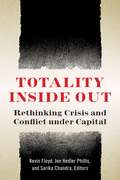
Totality Inside Out: Rethinking Crisis and Conflict under Capital
By Kevin Floyd, Jen Hedler Phillis, and Sarika Chandra. 2022
However divergent their analyses may be in other ways, some prominent anti-capitalist critics have remained critical of contemporary debates over…
reparative justice for groups historically oppressed and marginalized on the basis of race, gender, sexual identity, sexual preference, and/or ability, arguing that the most these struggles can hope to produce is a more diversity-friendly capital. Meanwhile, scholars of gender and sexuality as well as race and ethnic studies maintain that, by elevating the socioeconomic above other logics of domination, anti-capitalist thought fails to acknowledge specific forms and experiences of subjugation.The thinkers and activists who appear in Totality Inside Out reject this divisive logic altogether. Instead, they aim for a more expansive analysis of our contemporary moment to uncover connected sites of political struggle over racial and economic justice, materialist feminist and queer critique, climate change, and aesthetic value. The re-imagined account of capitalist totality that appears in this volume illuminates the material interlinkages between discrepant social phenomena, forms of oppression, and group histories, offering multiple entry points for readers who are interested in exploring how capitalism shapes integral relations within the social whole.Contributors: Brent Ryan Bellamy, Sarah Brouillette, Sarika Chandra, Chris Chen,Joshua Clover, Tim Kreiner, Arthur Scarritt, Zoe Sutherland, Marina Vishmidt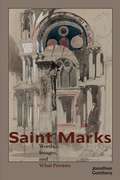
Saint Marks: Words, Images, and What Persists
By Jonathan Goldberg. 2019
Saint Marks invokes and pluralizes the figure of Mark in order to explore relations between painting and writing. Emphasizing that…
the saint is not a singular biographical individual in the various biblical and hagiographic texts that involve someone so named, the book takes as its ultimate concern the kinds of material life that outlive the human subject.From the incommensurate, anachronic instances in which Saint Mark can be located—among them, as Evangelist or as patron saint of Venice—the book traces Mark’s afterlives within art, sacred texts, and literature in conversation with such art historians and philosophers as Aby Warburg, Giorgio Agamben, Georges Didi-Huberman, T. J. Clark, Adrian Stokes, and Jean-Luc Nancy. Goldberg begins in sixteenth-century Venice, with a series of paintings by Gentile and Giovanni Bellini, Tintoretto, and others, that have virtually nothing to do with biblical texts. He turns then to the legacy of John Ruskin’s Stones of Venice and through it to questions about what painting does as painting. A final chapter turns to ancient texts, considering the Gospel of St. Mark together with its double, the so-called Secret Gospel that has occasioned controversy for its homoerotic implications.The posthumous persistence of a life is what the gospel named Mark calls the Kingdom of God. Saints have posthumous lives; but so too do paintings and texts. This major interdisciplinary study by one of our most astute cultural critics extends what might have been a purely theological subject to embrace questions central to cultural practice from the ancient world to the present.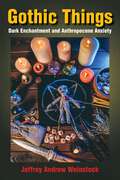
Gothic Things: Dark Enchantment and Anthropocene Anxiety
By Jeffrey Andrew Weinstock. 2023
SHORTLISTED, THE ALLAN LLOYD SMITH PRIZE FOR BEST MONOGRAPHOffering an innovative approach to the Gothic, Gothic Things: Dark Enchantment and…
Anthropocene Anxiety breaks ground with a new materialist analysis of the genre, highlighting the ways that, since its origins in the eighteenth century, the Gothic has been intensely focused on “ominous matter” and “thing power.” In chapters attending to gothic bodies, spaces, books, and other objects, Gothic Things argues that the Gothic has always been about what happens when objects assume mysterious animacy or potency and when human beings are reduced to the status of just one thing among many—more powerful—others.In exploring how the Gothic insistently decenters the human, Jeffrey Andrew Weinstock reveals human beings to be enmeshed in networks of human and nonhuman forces mostly outside of their control. Gothic Things thus resituates the Gothic as the uncanny doppelgänger of twenty-first-century critical and cultural theory, lurking just beneath the surface (and sometimes explicitly surfacing) as it haunts considerations of how human beings interact with objects and their environment. In these pages the Gothic offers a dark reflection of the contemporary “nonhuman turn,” expressing a twenty-first-century structure of feeling undergirded by anxiety over the fate of the human: spectrality, monstrosity, and apocalypse.Substituting horror for hope, the Gothic, Weinstock explains, has been a philosophical meditation on human relations to the nonhuman since its inception, raising significant questions about how we can counter anthropocentric thought in our quest to live more harmoniously with the world around us.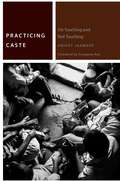
Practicing Caste: On Touching and Not Touching (Commonalities)
By Aniket Jaaware. 2018
Practicing Caste attempts a fundamental break from the tradition of caste studies, showing the limits of the historical, sociological, political,…
and moral categories through which it has usually been discussed. Engaging with the resources phenomenology, structuralism, and poststructuralism offer to our thinking of the body, Jaaware helps to illuminate the ethical relations that caste entails, especially around its injunctions concerning touching. The resulting insights offer new ways of thinking about sociality that are pertinent not only to India but also to thinking the common on a planetary basis.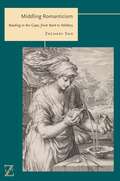
Middling Romanticism: Reading in the Gaps, from Kant to Ashbery (Lit Z)
By Zachary Sng. 2020
Romanticism is often understood as an age of extremes, yet it also marks the birth of the modern medium in…
all senses of the word. Engaging with key texts of the romantic period, the book outlines a wide-reaching project to re-imagine the middle as a constitutive principle. Sng argues that Romanticism dislodges such terms as medium, moderation, and mediation from serving as mere self-evident tools that conduct from one pole to another. Instead, they offer a dwelling in and with the middle: an attention to intervals, interstices, and gaps that make these terms central to modern understandings of relation.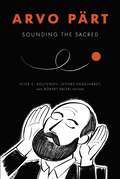
Arvo Pärt: Sounding the Sacred
By Peter C. Bouteneff, Jeffers Engelhardt, and Robert Saler. 2021
Scholarly writing on the music of Arvo Pärt is situated primarily in the fields of musicology, cultural and media studies,…
and, more recently, in terms of theology/spirituality. Arvo Pärt: Sounding the Sacred focuses on the representational dimensions of Pärt’s music (including the trope of silence), writing and listening past the fact that its storied effects and affects are carried first and foremost as vibrations through air, impressing themselves on the human body. In response, this ambitiously interdisciplinary volume asks: What of sound and materiality as embodiments of the sacred, as historically specific artifacts, and as elements of creation deeply linked to the human sensorium in Pärt studies? In taking up these questions, the book “de-Platonizes” Pärt studies by demystifying the notion of a single “Pärt sound.” It offers innovative, critical analyses of the historical contexts of Pärt’s experimentation, medievalism, and diverse creative work; it re-sounds the acoustic, theological, and representational grounds of silence in Pärt’s music; it listens with critical openness to the intersections of theology, sacred texts, and spirituality in Pärt’s music; and it positions sensing, performing bodies at the center of musical experience. Building on the conventional score-, biography-, and media-based approaches, this volume reframes Pärt studies around the materiality of sound, its sacredness, and its embodied resonances within secular spaces.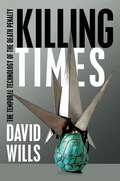
Killing Times: The Temporal Technology of the Death Penalty
By David Wills. 2019
Killing Times begins with the deceptively simple observation—made by Jacques Derrida in his seminars on the topic—that the death penalty…
mechanically interrupts mortal time by preempting the typical mortal experience of not knowing at what precise moment we will die. Through a broader examination of what constitutes mortal temporality, David Wills proposes that the so-called machinery of death summoned by the death penalty works by exploiting, or perverting, the machinery of time that is already attached to human existence. Time, Wills argues, functions for us in general as a prosthetic technology, but the application of the death penalty represents a new level of prosthetic intervention into what constitutes the human.Killing Times traces the logic of the death penalty across a range of sites. Starting with the legal cases whereby American courts have struggled to articulate what methods of execution constitute “cruel and unusual punishment,” Wills goes on to show the ways that technologies of death have themselves evolved in conjunction with ideas of cruelty and instantaneity, from the development of the guillotine and the trap door for hanging, through the firing squad and the electric chair, through today’s controversies surrounding lethal injection. Responding to the legal system’s repeated recourse to storytelling—prosecutors’ and politicians’ endless recounting of the horrors of crimes—Wills gives a careful eye to the narrative, even fictive spaces that surround crime and punishment.Many of the controversies surrounding capital punishment, Wills argues, revolve around the complex temporality of the death penalty: how its instant works in conjunction with forms of suspension, or extension of time; how its seeming correlation between egregious crime and painless execution is complicated by a number of different discourses. By pinpointing the temporal technology that marks the death penalty, Wills is able to show capital punishment’s expansive reach, tracing the ways it has come to govern not only executions within the judicial system, but also the opposed but linked categories of the suicide bombing and drone warfare. In discussing the temporal technology of death, Wills elaborates the workings both of the terrorist who produces a simultaneity of crime and “punishment” that bypasses judicial process, and of the security state, in whose remote-control killings the time-space coordinates of “justice” are compressed and at the same time disappear into the black hole of secrecy.Grounded in a deep ethical and political commitment to death penalty abolition, Wills’s engaging and powerfully argued book pushes the question of capital punishment beyond the confines of legal argument to show how the technology of capital punishment defines and appropriates the instant of death and reconfigures the whole of human mortality.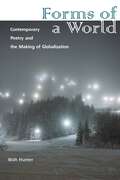
Forms of a World: Contemporary Poetry and the Making of Globalization
By Walt Hunter. 2019
What happens when we think of poetry as a global literary form, while also thinking the global in poetic terms?…
Forms of a World shows how the innovations of contemporary poetics have been forged through the transformations of globalization across five decades. Sensing the changes wrought by neoliberalism before they are made fully present, poets from around the world have creatively intervened in global processes by remaking poetry’s formal repertoire. In experimental reinventions of the ballad, the prospect poem, and the ode, Hunter excavates a new, globalized interpretation of the ethical and political relevance of forms. Forms of a World contends that poetry’s role is not only to make visible thematically the violence of global dispossessions, but to renew performatively the missing conditions for intervening within these processes. Poetic acts—the rhetoric of possessing, belonging, exhorting, and prospecting—address contemporary conditions that render social life ever more precarious. Examining an eclectic group of Anglophone poets, from Seamus Heaney and Claudia Rankine to Natasha Trethewey and Kofi Awoonor, Hunter elaborates the range of ways that contemporary poets exhort us to imagine forms of social life and enable political intervention unique to but beyond the horizon of the contemporary global situation.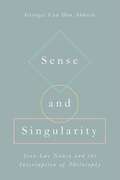
Sense and Singularity: Jean-Luc Nancy and the Interruption of Philosophy
By Georges Van Den Abbeele. 2023
Philosophical thinking is interrupted by the finitude of what cannot be named, on the one hand, and that within which…
it is subsumed as one of multiple modes of sense-making, on the other. Sense and Singularity elaborates Jean-Luc Nancy’s philosophical project as an inquiry into the limits or finitude of philosophy itself, where it is interrupted, and as a practice of critical intervention where philosophy serves to interrupt otherwise unquestioned ways of thinking. Nancy’s interruption of philosophy, Van Den Abbeele argues, reveals the limits of what philosophy is and what it can do, its apocalyptic end and its endless renewal, its Sisyphean interruption between the bounds of infinitely replicating sense and the conceptual vanishing point that is singularity. In examinations of Nancy’s foundational rereading of Descartes's cogito as iterative, his formal experimentations with the genres of philosophical writing, the account of “retreat” in understanding the political, and the interruptive play of sense and singularity in writings on the body, sexuality, and aesthetics, Van Den Abbeele offers a fresh account of one of our major thinkers as well as a provocative inquiry into what philosophy can do.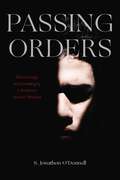
Passing Orders: Demonology and Sovereignty in American Spiritual Warfare
By S. Jonathon O'Donnell. 2021
Demonization has increasingly become central to the global religious and political landscape. Passing Orders interrogates this centrality through an analysis…
of evangelical “spiritual warfare” demonologies in contemporary America. Situating spiritual warfare as part of broader frameworks of American exceptionalism, ethnonationalism, and empire management, author S. Jonathon O’Donnell exposes the theological foundations of the systems of queer- and transphobia, anti-blackness, Islamophobia, and settler colonialism that justify the dehumanizing practices of the current U.S. political order.O’Donnell argues that demonologies are not only tools of dehumanization but also ontological and biopolitical systems that create and maintain structures of sovereign power, or orthotaxies—models of the “right ordering” of space, time, and bodies that stratify humanity into hierarchies of being and nonbeing. Alternative orders are demonized as passing, framed as counterfeit, transgressive, and transient. Yet these orders refuse to simply pass on, instead giving strength to deviant desires that challenge the legitimacy of sovereign violence. Critically examining this challenge in the demonologies of three figures—Jezebel, the Islamic Antichrist, and Leviathan—Passing Orders re-imagines demons as a surprising source of political and social resistance, reflecting fragile and fractious communities bound by mutual passing and precarity into strategic coalitions of solidarity, subversion, and survival.